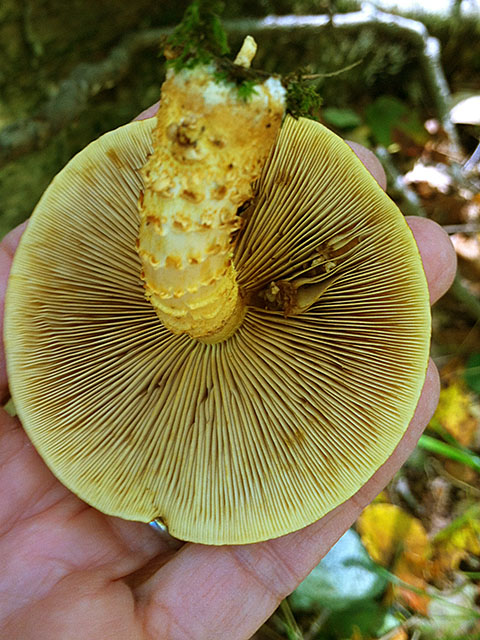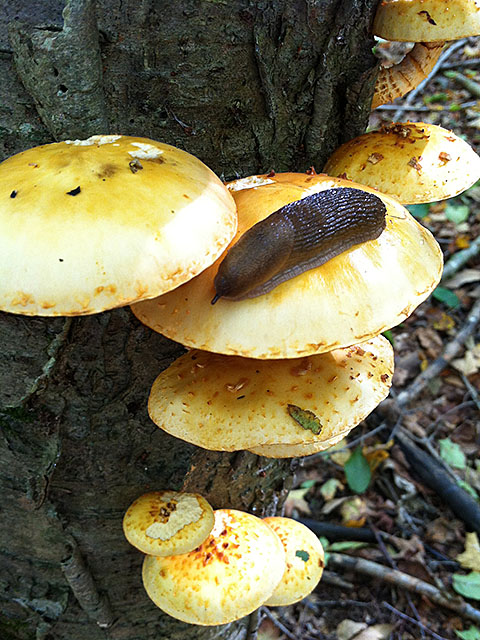The season is beginning to slide through the end of summer and toward the beginning of fall. The temperatures during the day are still summer, but the nights are becoming fall cool. The sun no longer climbs so high in the sky at noon and each day it rises a couple of minutes later and sets a couple of minutes earlier. The nature’s colors are shifting, too — purples, yellows, and whites contrast with a green that’s dustier and no longer quite as brilliant as it was just weeks ago. Some of the smaller trees are definitely feeling the effects of the heat and lack of water, showing their stress in their yellowed leaves. And the evening insect chorus is quieter, no longer quite so overwhelming. Fall isn’t here yet, but you can smell it coming. It’s time to get outside and enjoy the coming changes — they happen every day.
9/5 Remnants of tropical storm Issac brought rain this morning but by afternoon the sun was out and a few monarch butterflies floated by.
Monarch butterflies bred in the Hudson River watershed migrate south as much as 2,700 miles to a wintering location in a mountain forest near Mexico City. They arrive in large numbers to the same roosts, often to the exact same trees. The length of the journey far exceeds the lifetime of a single monarch, which is less than two months for butterflies born in early summer. The last generation of the summer lives up to seven months, during which time it migrates to the wintering location. This generation does not reproduce until it leaves the following spring. How monarchs manage to return to the same wintering locale over a span of several generations is a mystery. It is their children’s grandchildren that return south the following fall. [Tom Lake, from The Hudson River Almanac.]
9/7 Everything is perking along in the bee yard just fine. The summertime, coupled with what I assume to be my masterful manipulations designed to fool the bees into thinking that they swarmed, will be yielding a bumper crop of wildflower honey. I gaze out daily from my deck toward the hives tucked under the overhang of the tall maples. The overwintered hives are shaded from the late day sun and this viewing angle allows me to see the foragers, highlighted against the darker pine forest, shooting out from the hives into the blue sky to the south. The comings and goings are a wonderful sight laden with the promise of those girls, loaded with pollen and nectar, filling the cells of the hive frames.
9/8 After the rain, when the breeze from the north kicks in, will the hummingbirds hitch a ride on the tail winds as they start their journey to South America?
9/10 The “Hummers” are still here!!
9/11 Look what I found on my back porch:
 On a tree, this guy is really hard to see! — Photo by Beth Herr
On a tree, this guy is really hard to see! — Photo by Beth HerrA walking stick insect! What great camouflage and they make great pets! Here are some reasons why (and why not).
Advantages of walking stick pets:
- They eat lettuce, which means that you don’t have to grow exotic plants just to feed them.
- They can’t “infest” your house so you don’t have to worry about any “escapees.”
- They teach children to care for life, so they can be an ideal first pet for youngsters.
- They have a life span of about one school year, which makes them ideal for a year-long school class project.
- They have no wings so they can’t fly and escape.
- They walk relatively slowly and carefully, so they don’t scurry like roaches which tend to give “insecta-phobes” the “willies.”
- They can be handled easily by children without fear of being bitten or of squishing them.
- They don’t need daily care. They can be left for several days (up to a week) without care (they don’t need a baby-sitter for a weekend trip).
- They can be used to teach children (and adults) the value of life.
Disadvantages of walking stick pets:
- They breed well if cared for properly.
- Special Exotic Pet Permits are usually needed in most locations. In North America and probably most countries, these are usually only given for research or special purposes and not for general pet use.
- There can be devastating ecological results if non-native species of these insects are released into the wild.
List of advantages and disadvantages adapted from Walking Stick Insects – The Perfect Insect Pet; by John Locke, Department of Biological Sciences, University of Alberta, Edmonton, Alberta, Canada
9/12 The hummingbirds are gone, time to take down the feeders.
9/21 Hiking down to Horsepound Brook to sample the stream as part of the WAVE project (Wade-able Assessments by Volunteer Evaluators), we found mayfly, stonefly, and dragonfly larva as well as other aquatic invertebrates. And along the way we enjoyed the yellows of autumn: maples, grasses, and mushrooms. Saw this beauty — identified bu Lou Tartaro as Pholiota sp., probably Pholiota Squarrasoieds:
 Last night’s heavy rain made all the mushrooms blossom! — Photo by Beth Herr
Last night’s heavy rain made all the mushrooms blossom! — Photo by Beth HerrAnd this guy resting in a sunny spot:
 A nice place for a rest — Photo by Beth Herr
A nice place for a rest — Photo by Beth Herr9/29 The Harvest Moon—the full moon closest to the autumn equinox—has set for 2012. According to The Farmer’s Almanac, the Native Americans named the Harvest Moon. It marked when the corn was to be harvested. At the peak of harvest, before tractor lights, farmers worked by the the light of the moon to gather their crops. Another name for the Harvest Moon is the Full Corn Moon. When the Harvest Moon arrives on the same night as the autumn equinox, it is called the Super Harvest Moon. The last time a Super Harvest Moon occurred was in 2010. It won’t occur again until 2029.
